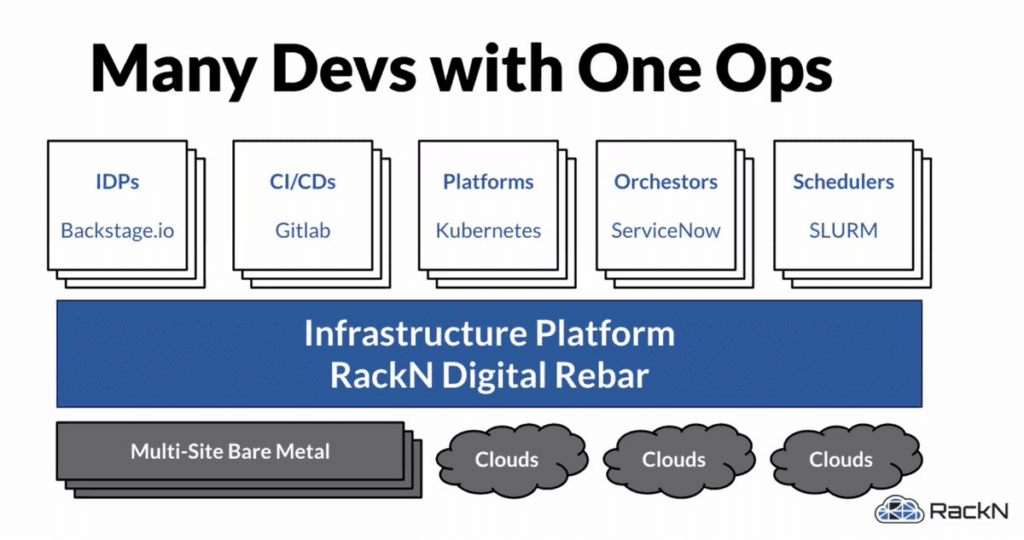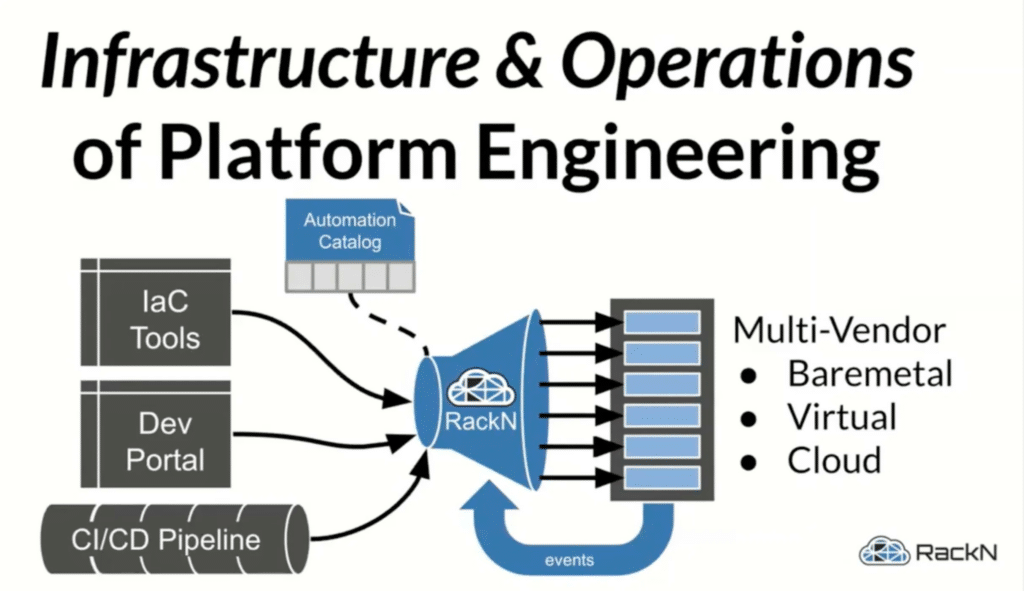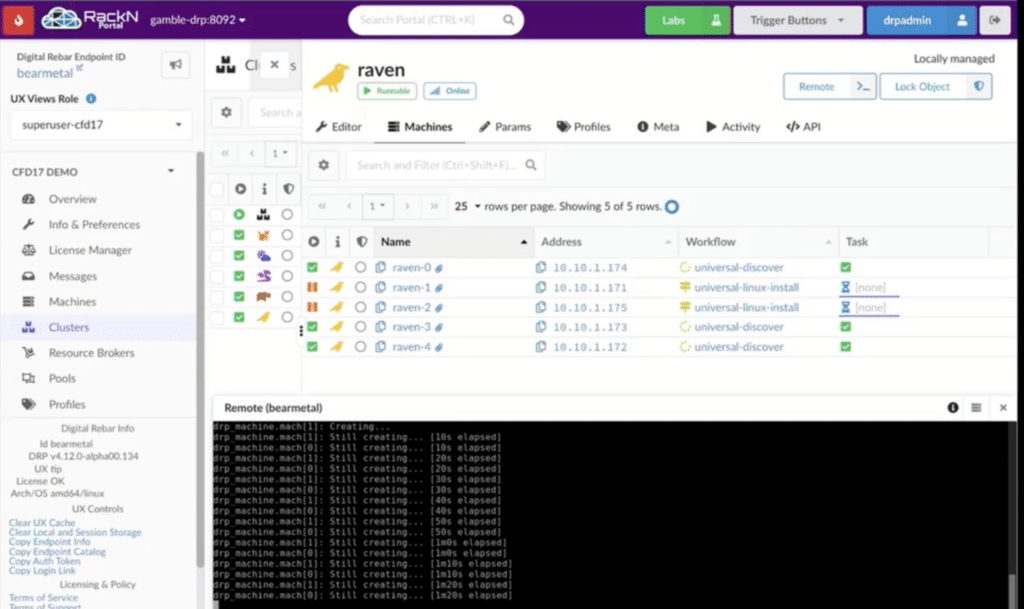There are very few days that I don’t think of a way to leverage RackN in some way. RackN has been described in many ways over time as the platform evolves. I like to refer to it as a distributed infrastructure orchestration, automation, and lifecycle platform.

What it does is really cool. How it does it has been the most amazing part of the story. What began as a bare metal story has evolved into a complete enterprise infrastructure management platform. Infrastructure-as-Code has aimed at codifying infrastructure and applications
Available. Reliable. Fast.
There is a 3-part problem. Any platform that is being offered to be a core part of production operations requires resiliency and speed. The resiliency comes with ensuring availability of the service when needed and being able to handle failure scenarios effectively and safely. Resiliency is also about reliability which is measured by metrics like automation success rate, automation half-life, and change failure rate.
Speed is about being able to offset time and effort being spent by people either waiting for infrastructure or managing infrastructure. Is time being wasted in day-to-day operations? Are your developers or platform consumers waiting days or even weeks to get access to infrastructure?
These challenges are usually just broadly accepted as “it is what it is” by many Ops teams because there has not been an alternative approach without terrible complexity and costs wrapped into it. This is why it’s been amazing to see how quickly RackN can show the value of what they are doing by freeing up people resources and reducing toil. If you didn’t think it could be done without a huge time and capital investment, you’re in for a treat.
RackN Architecture and Catalog FTW!
One of the wins with SaaS tools and cloud providers has been the ability to learn from one customer and have the benefit realized by other customers. By being a distributed platform that runs in the customer environment, RackN offers the best of both.
You get the control over the software and everything in the lifecycle. The second win is that other manifests and processes that are developed and honed by others can be pulled into your catalog.

The next thing you’re likely asking is whether you are the right audience to look at RackN.
Who is RackN for?
It’s important to know who uses the RackN platform. Ops teams are the likely first persona who will be running RackN automation, but they also have many customers they service.

There will be a minimum amount of change that is likely to spur the need for adopting infrastructure automation. My litmus test is “are you running Terraform or Ansible?” = yes you are likely in need of what RackN can do.

The more we automate application development, testing, and deployment, the more we need to automate the way in which is is hosted. Why should we expect less? Running hybrid and private cloud like public cloud platform engineers seems like a panacea. We see with RackN that it’s actually possible finally.
Bare Metal Terraform and RackN
Lots of teams are using bare metal to get closer to direct hardware performance. This may even be just deploying the original OS or virtualization platform (e.g. VMware vSphere). Installing a hosting platform has been either very manual or very expensive using some proprietary tools.
The demo being run in this session looks at a pool of machines and shows how to check out a machine, choose a deployment profile, do security audits, run the deployment, and also ends with reclaiming the hardware to the pool for reuse and redeployment as needed.

The developer can write their Terraform deployment just like they may have for their own build, but now they use RackN as the way to run the Terraform. This opens up so much more because the resources don’t need to be just AWS or Azure which are the most popular because infrastructure is available on-demand.

This process ran Terraform, which then installed and ran Ansible playbooks on the machines. State is determined and stored in the RackN platform and this means that as you do changes, updates, and de-provisioning processes that RackN manages the hardware and virtualization lifecycle.
Super cool!
Backstage and RackN Demo
How do you set up a pre-defined cluster? Lots of people are dabbling with Backstage but there are still some challenges that exist. Backstage, like Terraform, solved a specific problem. Backstage is a platform developed by the team at Spotify which tries to solve specific issues of developer and ops productivity with infrastructure automation.
RackN Digital Rebar is built to solve a seemingly similar sounding problem, but it’s done in a universal way. RackN allows for highly heterogeneous environments to get consistency regardless of the underlay.
The demo walked through how a similar process would be run just with Backstage but then shows the integration with RackN so that you get the best of both worlds. The developers can still use Backstage because of familiarity while getting the breadth of features and reliability of RackN Digital Rebar.
This will be handy for Day 2 operations as much as with initial provisioning.
Platform Engineering and Infrastructure Operations
Platform engineering is not easy, but it should be easier. This is where RackN shines. It’s a versatile platform for centrally controlled, distributed infrastructure operations. Platform engineering is really a derivative of SRE, or Site Reliability Engineering. Reliability is the important word.
RackN is tightly focused on enhancing the reliability of the operations experience. As a result of doing that, they are also making a fantastic developer experience. Even if developers are not directly interacting with RackN they get the advantages. It’s even better for developers because they can use their tool of choice.
Try it Out
Luckily the platform is easy to test drive and you can check out the demo options here for your own chance to try out your use-case.
About RackN
RackN Digital Rebar is a vendor-neutral Infrastructure-as-Code automation platform that scales IaC automation with reusable workflows that can be deployed on any platform. RackN was founded with vision of operators working together to improve IT operations through shared software and community regardless of infrastructure type.
RackN website: https://rackn.com
RackN on Crunchbase: https://www.crunchbase.com/organization/rackn-inc
RackN on Owler: https://www.owler.com/company/rackn
Disclosure
Travel and expenses for Tech Field Day – Cloud Field Day 17 were provided by the Tech Field Day organization, GestaltIT. No compensation was received for attending the event. All content provided in my posts is of my own opinion based on independent research and information gathered during the sessions.
